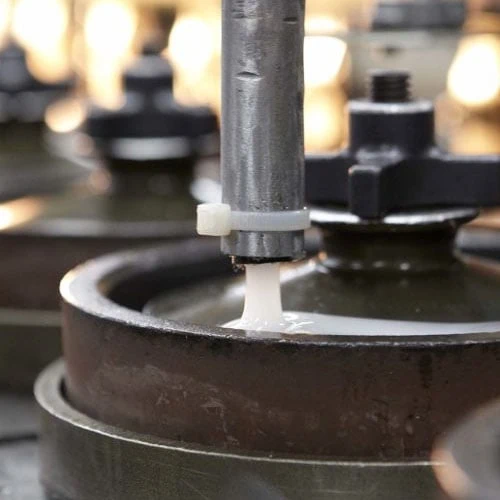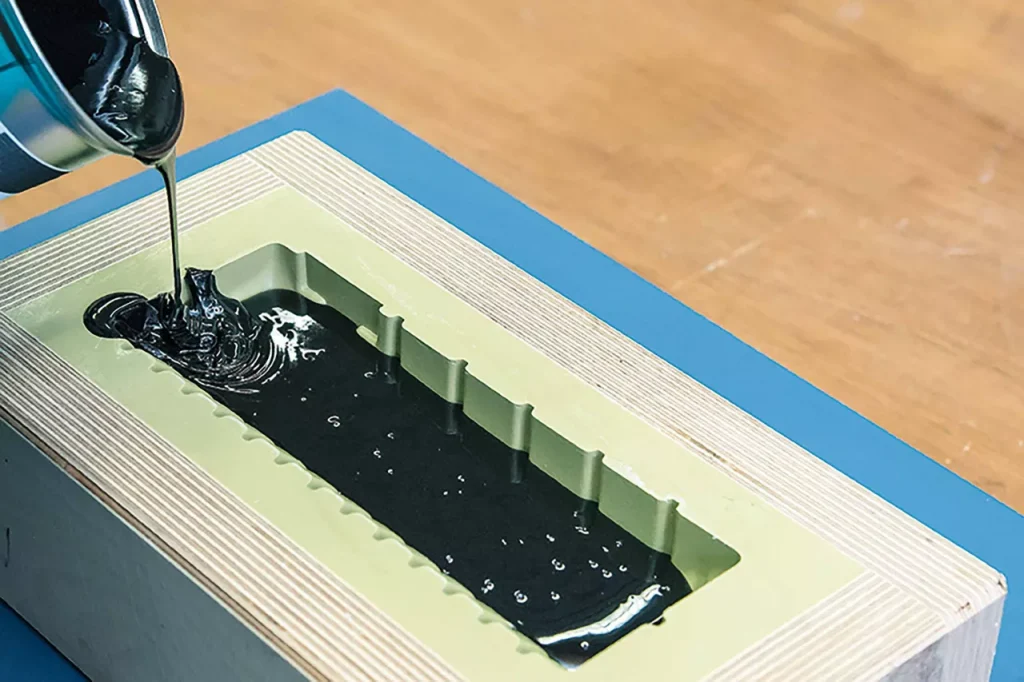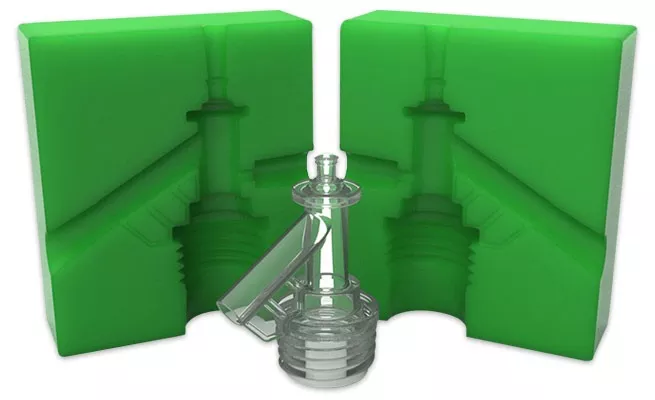Polyurethane casting is a low-cost, traditional molding process for making rigid or rubber-like plastic parts. Polyurethane casting is commonly used for small production runs of parts for market testing prototypes (rapid prototyping), personalized products, custom medical devices, etc. It does not require expensive rigid metal molds but rather uses silicone molds to create effective quantities of castings. Polyurethane casting makes it easy to add color to castings before and after the manufacturing process, and it can also cast products such as clear electronic housings and presentation boxes using transparent materials. Thus, giving customers various casting options, but only if they go out to rigid and flexible parts.
This article discusses what is polyurethane casting. What materials are used? Advantages and disadvantages? Applications? and the differences between CNC machining, injection molding, etc.
Note: Vacuum casting is better known as polyurethane or urethane casting in the United States. This article will use these terms interchangeably.
What is polyurethane casting?
Polyurethane casting is similar to injection molding in that the molds are soft and flexible rather than hard metal. This makes polyurethane casting more cost-effective than injection molding, especially for producing small quantities of parts and with shorter lead times.
This is the production of plastic and rubber parts using a silicone mold under vacuum using polyurethane resin, where the polyurethane resin is cast in a cavity between two silicone half-molds, also known as vacuum casting. The overall process is as follows.
During the polyurethane casting process, the master mold is placed inside a sealed box, covered with liquid silicone, and cured. After the silicone has solidified, the manufacturer cuts it in half to release the master mold. At this point, the casting polyurethane mold is ready for use.
To make a custom polyurethane casting part, engineers pour polyurethane casting resin (usually a polyurethane material that can mimic the physical properties of the plastic used in injection molding) into the mold and cure it in an oven. The final part usually requires little (if any) post-treatment.
By eliminating the metal mold, polyurethane casting is a less expensive process that is faster but retains the quality of the product molded. Castable polyurethanes are part of a family of polyurethanes that can be made into high-performance, engineering-grade products. The mechanical properties of cast polyurethanes can vary from soft and flexible materials to rigid and rigid materials.

How does polyurethane casting work, and what are the steps?
So, how does polyurethane casting work? Polyurethane casting technology is similar to traditional injection molding, requiring molds with cavities shaped like components. However, while injection molds are metal (steel and aluminum), polyurethane casting uses soft silicone molds. The following instructions show you how to make a polyurethane casting.
1. Create a master pattern using 3D CAD software, convert it to an STL file, slice it into layers using 3D printing software, and then 3D print using stereolithography (SLA) or PolyJet to provide the pattern for the silicone molding process. Tip: Once the master model is complete, place the tape on any flat surface to cleanly remove the castings during post-processing.
2. Build the mold cartridge around the master model (mimicking a flask used in metal casting), then encapsulate it in liquid silicone to form the mold tool and cure it for an average of 18-24 hours.
3. The mold is then cut into two different halves with a very sharp cutting tool so that the two halves fit together better. The main pattern is then removed. The remaining cavity is then used to cast the end-use part. Tip: Any features that may be fatigued by multiple casting (e.g., through holes) should be replaced with pins.
4. Once the tool is created, the resin of your choice is injected into the cavity of the mold tool to form the part. The resin must be allowed to cure (usually in a heated vacuum chamber) before the finished part is removed from the tool. Any excess material flash or gait needs to be removed. This is caused by leakage between the mold’s two surfaces and the resin’s entry point into the mold.
The main materials used in polyurethane casting
There is a wide variety of vacuum casting materials with different properties in terms of flexibility, elasticity, stiffness, and hardness:
ABS-like general-purpose resins, glass-filled nylon-like materials, elastomer-like TPE, PC-like (polycarbonate), translucent or clear casting polyurethanes (PMMA-like), POM-like or PU-like heat-resistant materials similar to PP, PA, ABS, PEHD… There are also special polyurethane casting materials such as crushed glass, waxes, epoxies, ceramics, and composites, as well as food grade, conductive, low density, and flame retardant materials.
Why choose polyurethane casting?
Polyurethane casting allows the production of different castings through different secondary molding processes: inserts, shafts, cables… This technique allows using a wide range of materials suitable for small production runs, including food resins, flame retardants suitable for electrical use, filled glass fibers, and transparency.
Different materials in polyurethane/vacuum casting allow the production of various products with different mechanical stresses, which can be significant depending on the product design. The hardness of the parts can also be adjusted as needed, allowing soft or flexible parts to be cast. And it is also possible to color the whole part.
This makes polyurethane casting the perfect solution for rapid prototyping and low-cost, low-volume manufacturing. The molds used in this manufacturing process are inexpensive and so finely crafted that little post-production of prototypes is required. Each mold can be printed in about 25-30 pieces for rapid production. For small production runs, it is more economical than plastic injection molding. However, high-quality polyurethane castings are less suitable for long-term dosing.
Advantages and disadvantages of polyurethane casting
Advantages of polyurethane casting
1. Multiple components in a master model can be produced quickly within 24 hours, thus shortening the product design prototype phase and saving time and money on new product development.
2. Polyurethane casting can produce small quantities of high-quality injection molded prototype and end-use parts for low-stress and fairly benign environments.
3. Various polyurethane casting resins are available for various applications, including clear resins, rubber resins, flame retardant resins, food-grade resins, and colored resins.
4. Resin types can be changed without reworking to evaluate various material types for a given application or project.
5. Multi-section molds and cores can handle complex shapes and features.
6. Inserts made of aluminum or brass can also improve the accuracy of certain features, such as thread forms and tight fits.
Disadvantages of polyurethane casting
1. Since the mold is soft silicone, it wears quickly and lasts only 30 – 50 parts. Surface texture, part characteristics, and tool size determine tool wear. The mold life will be shortened if the part is larger, has a rougher surface texture, and has many proud features.
2. As with injection molding, shrinkage can cause uneven, unusually thin, and thick features to deviate from standard tolerances.
3. Thermal expansion of liquid and flexible molds results in 15% – 25% shrinkage. Manufacturers will usually allow shrinkage tolerances, but talking to them before placing an order is recommended.
4. Since the surface finish depends on the part’s post-treatment, it is sometimes limited to the outside because some internal aspects of the design cannot be achieved.
5. Sharp corners and letters may sometimes have softened edges.
6. Certain features may also require connectors and core wires.
7. Precise color matching may be very difficult.

Design Tips for Polyurethane Casting
Polyurethane casting is less expensive and time-consuming than rigid molds, making it ideal for rapid prototyping and small to medium-volume production of complex structures. To take full advantage of this manufacturing process, product teams must design for manufacturability and optimize the mold design early to streamline the production process and keep costs low. Here are five basic design tips for creating clean and fully functional custom-cast polyurethane parts
1. Uniform wall thickness
Many engineers prefer urethane casting over injection molding because of the greater wall thickness variability of the former. However, ensuring that a given urethane mold design has uniform walls is still important. Uniform walls reduce the risk of deformation during curing, ensure the mold is completely and accurately filled, and mitigate other design issues.
A minimum wall thickness of 0.040 inches (1 mm) is recommended, but in some cases, small parts may have walls as thin as 0.020 inches (0.5 mm). For larger parts, wall thickness should always increase in proportion to the size of the part to ensure that the wall can provide adequate support.
2. Consider shrinkage
Shrinkage may occur when two walls of different thicknesses intersect in a polyurethane mold design. Since the thicker wall will solidify more slowly than the thinner wall, the area where they attach to the nominal wall will shrink as the protrusions (ribs or tabs) shrink. This can result in depressed areas in the nominal wall. To minimize shrinkage and prevent recessed areas, engineers should ensure that the rib thickness is between 50% and 60% of the wall it is attached to.
Nevertheless, sometimes polyurethane cast parts shrink for reasons other than a defective mold design. The final size of a polyurethane cast part depends on the accuracy of the master model and mold, the part geometry, and the polyurethane casting material. 0.15% shrinkage is acceptable, but engineers should revisit their polyurethane mold design if shrinkage exceeds this threshold.
3. Consider mold pulling and undercutting
Mold pulling and undercutting is not an issue with urethane casting because liquid silicone can take on any mold shape. However, suppose engineers are using urethane casting to build prototypes that will eventually be manufactured using a different process (e.g., injection molding). In that case, they should design them according to the expectations of end-use production. This may include merging the mold pull and undercut. A long zero-draw feature presents a slight risk of part breakage when removing the part from the mold so a tiny angle may be useful, especially for larger production runs.
4. Allow sufficient spacing between letters and logos
With polyurethane casting, designers can easily mold high-quality raised or recessed letters and logos into custom-cast polyurethane parts. To ensure that letters are as aesthetically pleasing and readable as possible, designers should consider the height or feature depth, feature width, feature radius, and spacing between features.
Product teams should allow a minimum of 0.050 inches of spacing between features, although this may vary depending on the specifics of the design. All radii should be at least equal to half the height of the feature, but the larger the radius, the better. Finally, all logos or letters should be twice as wide as their height.
Urethane Casting and CNC Machining
Urethane casting and CNC machining are very different production techniques, but they can sometimes be used to produce similar parts. For example, both can make rigid plastic parts such as housings and are suitable for small production runs.
CNC machining is more precise than polyurethane casting and can create more detailed features. Unlike polyurethane casting, it is also compatible with various materials. The polyurethane casting process is much cheaper at any volume, especially when multiple units are required.
Polyurethane Casting and Injection Molding
The polyurethane casting and injection molding processes have many similarities, the main difference being the mold material: polyurethane casting has a soft silicone mold, while injection molding requires a metal mold.
Injection molding is better suited for medium to large order quantities and parts requiring more strength. Polyurethane casting is a low-cost alternative to injection molding when processing small quantities, as no expensive metal molds are required.
Vacuum Casting and 3D Printing
The misconception about 3D Printing is that it is a one-time use. Instead, it is a viable method for manufacturing end-use parts in small batches and can handle small production runs of hundreds or even thousands of products.
The product’s geometry is the main factor influencing the choice between 3D printing and vacuum casting. Vacuum casting is explicitly designed to mimic injection molded parts. As a low-investment alternative to full-size injection molding, it can even combine flexible and rigid materials in over-molding or add metal components directly to a prototype through insert molding. For manufacturing a small series of injection molded parts, vacuum casting is more cost-effective than 3D Printing.
Another advantage of vacuum casting is that larger parts can be manufactured faster and cheaper than 3D Printing. It allows for mold sizes up to approximately 50 cm (20 inches) and castings weighing up to 1.5 kg (3.3 lbs).
Applications of polyurethane casting
The polyurethane method has many applications and is used in almost every industry. The polyurethane casting process suits testing, initial, and small production runs. For example, they are made for marketing purposes or trade shows and to get early feedback directly from the customer’s first step to avoiding hardware startup failures. But prototypes are also often used in the technical field of assembly, construction, or functional testing.
Because of the wide variety of materials available for polyurethane casting and the many options for surface finishes, polyurethane casting allows for precise and targeted small production runs. The casting process is used if high-quality plastic or rubber parts are required. In summary, the polyurethane method is used in the following areas:
- prototypes
- as pre-series for market testing
- editorial brings you the first issue of marketing
- hard to get spare parts
- design models and exhibition models
- functional models
- accurate prototypes
- Aerospace parts (aerospace materials)
- multicolor components
Especially in the food industry, aircraft construction, automotive manufacturing, and medical technology, products are manufactured in series using the polyurethane process. Typical products made using vacuum casting include
- seals
- hoses
- displays
- sleeves
- camouflage
- Caps
Conclusion on polyurethane casting
Polyurethane casting is a simple process. It starts with a pattern made by 3D Printing or milling. The next step is the preparation of the silicone mold. The third step is the polyurethane formulation, mixing, and pouring. Then, finally, secondary processes such as drilling, cutting, and polishing are performed. Polyurethane casting is the preferred choice among the various processes for testing the appearance or functionality of a new product. The injection molding process, on the other hand, is relatively costly for small production runs. With the polyurethane casting process, prototypes and small batches can be produced inexpensively while maintaining high quality. In addition to the low production costs, the possibility of short-term production, the high production accuracy, and the possibility of producing parts with high complexity or integrated functions are the most important advantages of the process. The polyurethane casting process can achieve almost everything, from transparent to various color shades.
Please see our FAQ page to learn more about the polyurethane casting process, its uses, and surface finishes. Or, contact us today, and one of our experts will work with you to answer your questions.

